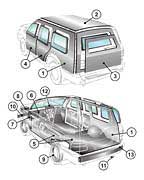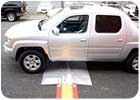And then came September 11th.
Security directors of large enterprises no longer had to beg for protection budgets for people and facilities.
This was good news and bad news. Security directors found that their preaching had finally been recognized as warranted. The bad news: Even though they advocated armor, many security executives were ill prepared to implement an armoring program.

There are 13 essential points to consider when armoring a vehicle. Artwork courtesy: Square One Armor Services
Armoring Resources Limited
There is no armoring textbook to guide security directors; many turn to the Internet. But there’s no vetting process for armorers, and there are no government safety or inspection standards. Hipsters, hucksters and all manner of imitators attempt to take advantage. The problem is compounded by unaware buyers who relied on the hype; the difference is that the results can be lethal.Take the case of a Fortune 100 firm that needed armor in various foreign locales. After some initial investigation, they discerned that most markets would dictate high handgun-level protection and a few needed rifle protection. They initiated contact with some self-styled “armorers” on the Web and got price quotes for Level 4 and Level 6 armor for the type of vehicle they wanted to buy. Specifications were provided by the armorer and the pricing appeared reasonable.
But later on, when the author’s consulting firm became involved, the security director was in for a few surprises. For one, the armor levels specified by the so-called armorer had no relation to accepted international standards. The bid said “Level 4” when it should have specified CEN B4 level, which is the highest handgun standard based on the Central European Norm and recognized worldwide. The international standards specify what type of bullet, muzzle velocity, kinetic joules of energy, distance from target and how many impacts it must defeat in a specified space. The wannabe armorer created a “Level 4” which would not meet international defeat standards. The rifle level armorer committed the same deception and, in fact, had never built any vehicle at the CEN B6 level.
The armorers had never tested one of their cars and, in fact, did not even batch test their raw materials for ballistic compliance. In other words, they accepted the materials they purchased and never determined if they would actually defeat the bullets the client thought they were protected from. Was this an isolated case? Sadly, no; it happens every day and has for years.
A Solution
There really is no armoring school or template for selecting, ordering and building through an armoring company.Once the end-user knows what to order, he or she must then determine that what’s ordered is what’s delivered; the armoring process has to be audited on–site with hands-on inspections. Materials have to be certified and batch tested. Seams and gaps in the armor have to be identified and corrected. Payloads and reinforcements must be examined. The check-sheet is lengthy and, unfortunately, there is no ramp up learning curve; it has to be right the first time.
One obvious option is to purchase a pre-armored car from a well-known automobile manufacturer. But most manufacturers do not make this modification. One of the oldest and best armorers is Mercedes-Benz; a special factory has armoring run by very skilled craftsmen who extensively test the product. Does this solve the problem for enterprise security directors? Not really. In many markets, the high cost and thus small number of (Mercedes) vehicles in operation quickly identifies the driver as wealthy and important. In essence, the car makes targeting easier.

You can armor cars but don’t forget to look under vehicles for hidden contraband and explosives. Emerging technology uses security video.
Check Under Vehicles, Too
Armoring vehicles is an important step for many multi-national enterprises. But there is also the threat of vehicles containing contraband or explosives, whether they are company cars or visitors.Often, security officers physically inspect vehicles or use mirrors to look under the car or truck or bus. Technology has advanced the inspection process.
Vehicle Inspection Technologies, Sterling, Va., has some unique technology it’s delivered to clients including an Und-Aware UVSS 400 Series product to the Kingdom of Saudi Arabia. Und-Aware includes above- and below-ground, fixed and portable systems ranging from two to eight cameras to scan the full width of any size vehicle.
Drive over cameras
The Und-Aware AG-400 provides eight high-resolution NTSC color camera images for sharp detail over a full 8-foot vehicle width. Four separate base assembly units incorporate what the company calls AirWash components, lights and readily replaceable camera modules. Special end modules provide a smooth ground transition, or connect to a cable management system.
An integrated unit within the security facility controls the cameras and AirWash in full A-76 (minimum-man) compliance. The control system features open architecture software for easy integration with existing security installations. Touch screen option, biometrics integration, data warehousing, data mining and customized reports are options.
“The first challenge we faced was to make a system that worked no matter what the weather,” said Bill Peterson, Und-Aware designer. Weather in Saudi Arabia can cause undue strain on components that already run “hot.” For this reason, the “cool” white LED lights will keep maintenance to a minimum.
Facing New Dilemmas
Armoring is a complex task involving physics, kinesiology, ballistic science and materials all related to the mission of the vehicle. For example, let’s say you have a facility in the Middle East that is a potential threat zone and your executives’ vehicles are not protected. Here’s just a few of the items you need to consider to implement an armoring program:- What vehicle will meet business use standards, blend in locally (units in operation, or UIO count) and can handle the weight and payload required once armored without violating OEM safety standards?
- What level of armor is needed?
- What builder can certify its armoring and provide a reliable warranty while not violating the OEM warranty?
- How do you implement a RFQ? What specifically should be detailed?
- What about duties and use taxes locally?
- What about servicing the vehicle in–market?